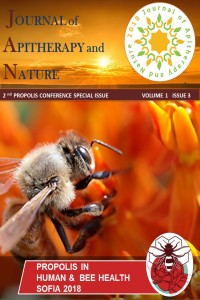Öz
Propolis (bee glue) is a well known natural product with healing
properties. The chemical composition of propolis is highly variable and depends
mainly on the local flora. As a part of a systematic research on bee-keeping products, two
propolis samples from Kyrgyzstan and Kazakhstan have
been studied for the first time due to their high and very interesting flora.
Chemical analysis of propolis samples was performed by GC/MS which is a very
useful and highly appreciated analytical tool, after silylation procedure1.
The results showed that both samples contain mainly aromatic acids (cinnamic,
caffeic and ferulic acids), esters of phenolic acids (pentenyl and phenylethyl
caffeates), flavonoids (galangin, pinocembrin, pinobanksin) as well as
chalcones of pinostrobin, pinocembrin and alpinon. These results confirm a
typical chemical profile characteristic for Temperate zone propolis2
while in both cases appear also an uncommon aliphatic acid content (oleic, linoleic, palmitic and stearic
acids) .
Furthermore, both
samples showed a high TPC (total phenolic content), determined by the
Folin-Ciocalteu method. Additionally, the ethanolic extracts were evaluated for
their antimicrobial activity, by the agar dilution technique against a panel of
human pathogenic microorganisms. The assays revealed broad spectrum of
antimicrobial activity specified against Gram positive bacteria as well as
against oral pathogenic ones.
Anahtar Kelimeler
Propolis (bee glue) Chemical Composition Kazakhstan Kyrgyzstan
Kaynakça
- 1. Popova Μ., Chinou Ι., Marekov Ι. and Bankova V. (2009). Terpenes with antimicrobial activity from Cretan propolis. Phytochemistry, 70: 1262-1271. 2. Bankova V., De Castro S.L., Marcucci M.C.: Apidologie 2000, 31, 3-15.
Öz
Kaynakça
- 1. Popova Μ., Chinou Ι., Marekov Ι. and Bankova V. (2009). Terpenes with antimicrobial activity from Cretan propolis. Phytochemistry, 70: 1262-1271. 2. Bankova V., De Castro S.L., Marcucci M.C.: Apidologie 2000, 31, 3-15.
Ayrıntılar
| Birincil Dil | İngilizce |
|---|---|
| Bölüm | 2nd Propolis Conference Special Issue |
| Yazarlar | |
| Yayımlanma Tarihi | 8 Aralık 2018 |
| Yayımlandığı Sayı | Yıl 2018 Cilt: 1 Sayı: 3 - 2nd Propolis Conference Special Issue |
Kaynak Göster
ASOS Index


